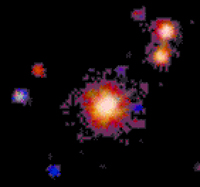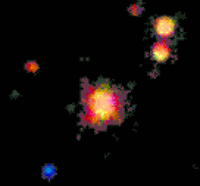November 9, 2000
MIT Press Release
Cambridge, Mass.--In resolving the hot core of one of the Earth's closest and most massive star-forming regions, the Chandra X-ray Observatory showed that almost all the young stars' temperatures are more extreme than expected.

JPEG, TIFF, PS
The Orion Trapezium as observed on October 31st UT 05:47:21 1999. The colors represent energy, where blue and white indicate very high energies and therefore exterme temperatures. The size of the X-ray source in the image also reflects its brightness, i.e. more bright sources appear larger in size. The is an artifact caused by the limiting blur of the telescope optics. The projected diameter of the field of view is about 80 light days. Credit: NASA/MIT

JPEG, TIFF, PS
The Orion Trapezium as observed on November 24th UT 05:37:54 1999. The colors represent energy, where blue and white indicate very high energies and therefore exterme temperatures. The size of the X-ray source in the image also reflects its brightness, i.e. more bright sources appear larger in size. The is an artifact caused by the limiting blur of the telescope optics. The projected diameter of the field of view is about 80 light days.
Credit: NASA/MIT
These Chandra images showcase the Orion Trapezium Cluster, a star-forming region in the constellation Orion. The images are dominated by various shades of blue, purple, and red, on a background of black. The Orion Trapezium Cluster is a well-known star-forming region that consists of four main stars: Theta 1 Orionis A, Theta 1 Orionis B, Theta 2 Orionis A, and Theta 2 Orionis B. The stars are arranged in a trapezoidal shape, hence the name Orion Trapezium Cluster. The colors represent energy, where blue and white indicate very high energies and therefore extreme temperatures. The size of the X-ray source in the images also reflects its brightness, i.e. more bright sources appear larger in size. This is an artifact caused by the limiting blur of the telescope optics.
The Orion Trapezium Cluster, only a few hundred thousand years old, offers a prime view into a stellar nursery. Its X-ray sources detected by Chandra include several externally illuminated protoplanetary disks ("proplyds") and several very massive stars, which burn so fast that they will die before the low mass stars even fully mature.
One of the major highlights of the Chandra observations are identification of proplyds as X-ray point source in the near vicinity of the most massive star in the Trapezium. Previous observations did not have the ability to separate the contributions of the different objects.
"We've seen high temperatures in stars before, but what clearly surprised us was that nearly all the stars we see appear at rather extreme temperatures in X-rays, independent of their type," said Norbert S. Schulz, MIT research scientist at the Chandra X-ray Center, who leads the Orion Project. "And by extreme, we mean temperatures which are in some cases well above 60 million degrees." The hottest massive star known so far has been around 25 million degrees.
The great Orion Nebula harbors the Orion Nebula Cluster (ONC), a loose association of around 2,000 mostly very young stars of a wide range of mass confined within a radius of less than 10 light years. The Orion Trapezium Cluster is a younger subgroup of stars at the core of the ONC confined within a radius of about 1.5 light years. Its median age is around 300,000 years.
The constant bright light of the Trapezium and its surrounding stars at the heart of the Orion nebula (M42) are visible to the naked eye on clear nights.
In X-rays, these young stars are constantly active and changing in brightness, sometimes within half a day, sometimes over weeks.
"Never before Chandra have we seen images of stellar activity with such brilliance," said Joel Kastner, professor at the Chester F. Carlson Center for Imaging Science at the Rochester Institute of Technology. "Here the combination of very high angular resolution, with high quality spectra that Chandra offers, clearly pays off."
The observation was performed using the High Energy Transmission Grating Spectrometer (HETGS) and the X-ray spectra were recorded with the spectroscopic array of the Advanced CCD Imaging Spectrometer (ACIS). The ACIS detector is a sophisticated version of the CCD detectors commonly used in video cameras or digital cameras. The orion stars are so bright in X-rays that they easily saturate the ccds. Here the team used the gratings as a blocking filter.

JPEG, TIFF, PS
X-ray contours of the Chandra observation overlaid onto the optical Hubble image (courtesy of J. Bally, CASA Colorado). The field of view is 30"x30". Besides the bright main Trapezium stars, which were found to be extremely hot massive stars, several externally illuminated objects are also X-ray emitters. Some of them with temperatures up to 100 Million degrees. The ones that do not show X-ray contours are probably too faint to be detected in these particular Chandra observations.
Credit: J. Bally, CASA Colorad
It is generally assumed that low-mass stars like our Sun, when they are young, are more than 1,000 times more luminous in X-rays. The X-ray emission here is thought to arise from magnetic activity in connection with stellar rotation. Consequently, high temperatures would be observed in very violent and giant flares. Here temperatures as high as 60 million degrees have been observed in very few cases. The absence of many strong flares in the light curves, as well as temperatures in the Chandra ACIS spectra wich exceed the ones in giant flares, could mean that they are either young protostars (i.e stars in the making), or a special class of more evolved, hot young stars.
Schulz concedes that although astronomers have gathered many clues in recent years about the X-ray behavior of very young stellar objects, "we are far from being able to uniquely classify evolutionary stages of their X-ray emission."
The five main young and massive Trapezium stars are responsible for the illumination of the entire Orion Nebula. These stars are born with masses 15 to 30 times larger than the mass of our Sun. X-rays in such stars are thought to be produced by shocks that occur when high velocity stellar winds ram into slower dense material.
The Chandra spectra show a temperature component of about 5 million to 10 million degrees, which is consistent with this model. However, four of these five stars also show additional components between 30 million and 60 million degrees.
"The fact that some of these massive stars show such a hot component and some not, and that a hot component seems to be more common than previously assumed, is an important new aspect in the spectral behavior of these stars," said David Huenemoerder, research physicist at the MIT Center for Space Research.
Standard shock models cannot explain such high temperatures, which may be caused by magnetically confined plasmas, which are generally only attributed to stars like the Sun. Such an effect would support the suspicion that some aspects in the X-ray emission of massive stars may not be different from our Sun, which also has a hot corona. More study is needed to confirm this conclusion.
The latest in NASA's series of Great Observatories. Chandra is the "X-ray Hubble," launched in July 1999 into a deep-space orbit around the Earth.
Chandra carries a large X-ray telescope to focus X-rays from objects in the sky. An X-ray telescope cannot work on the ground because the X-rays are absorbed by the Earth's atmosphere.
The HETGS was built by the Massachusetts Institute of Technology with Bruno Rossi Professor Claude Canizares as Principal Investigator. The ACIS X-ray camera was conceived and developed for NASA by Penn State and the Massachusetts Institute of Technology under the leadership of Gordon Garmire, Evan Pugh Professor of Astronomy and Astrophysics at Penn State. The Orion observation was part of Prof. Canizares guaranteed observing time during the first round of Chandra observations.
NASA's Marshall Space Flight Center in Huntsville, Alabama, manages the Chandra program. TRW Inc., Redondo Beach, California, is the prime contractor for the spacecraft. The Smithsonian's Chandra X-ray Center controls science and flight operations from Cambridge, Massachusetts.
To follow Chandra's progress, visit the Chandra site at:
Various Images for this release and a postscript version of a preprint of the accepted science paper (The Astrophysical Main Journal) can be downloaded from http://space.mit.edu/~nss/orion/orion.html


